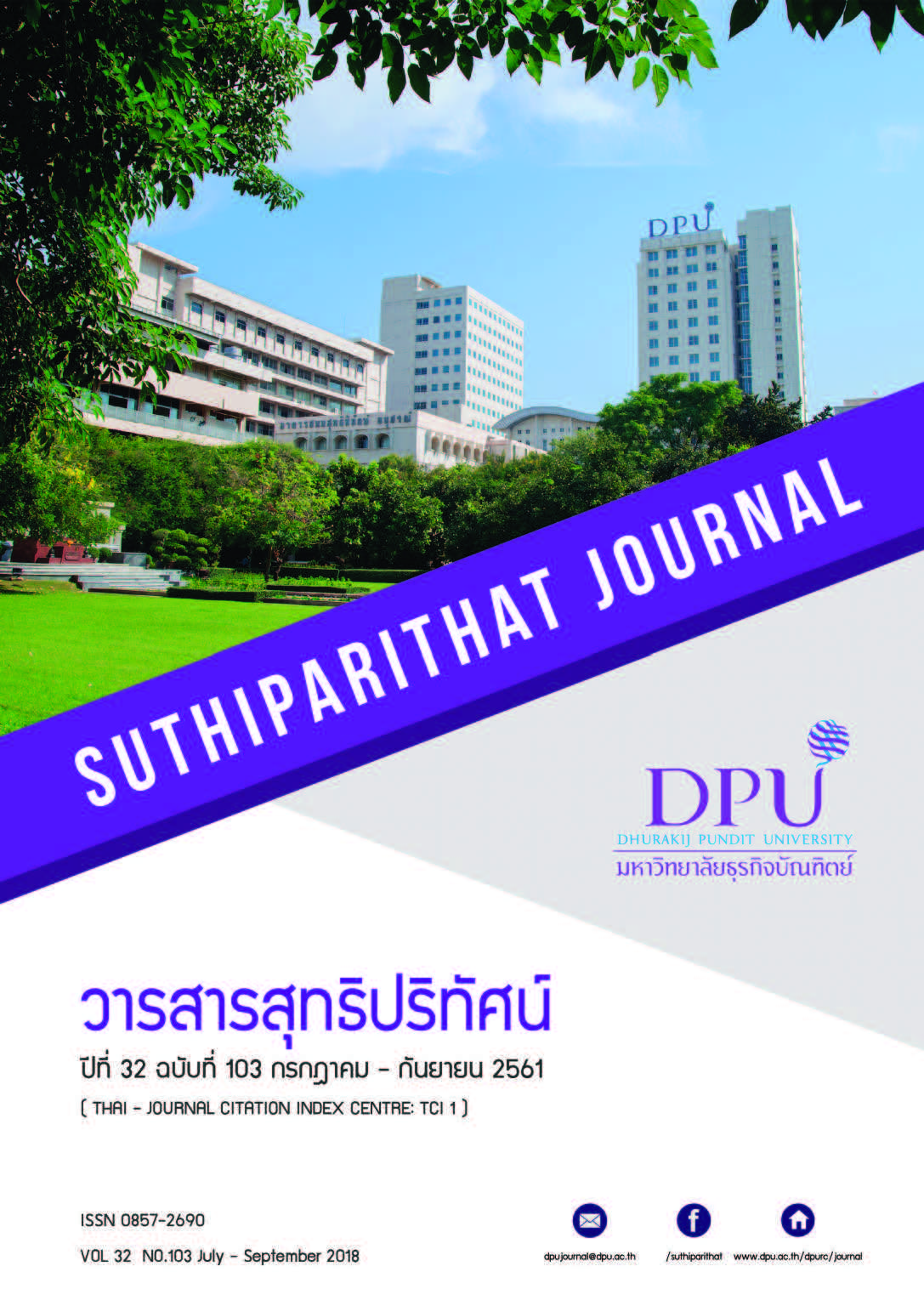ผลของยาสมุนไพรไทยตำรับตรีผลาในผู้ที่มีภาวะอ้วนระดับ 1 ที่มารับบริการในโรงพยาบาลมหาราชนครศรีธรรมราช
คำสำคัญ:
ตรีผลา, อ้วนบทคัดย่อ
การวิจัยมีวัตถุประสงค์เพื่อศึกษาผลของสมุนไพรตำรับตรีผลา ต่อดัชนีมวลกาย รอบเอว ระดับ น้ำตาลในเลือด ระดับไขมันในเลือด และคุณภาพชีวิตในผู้ที่เป็นภาวะอ้วนระยะที่ 1 การศึกษาเป็นการวิจัยเชิงทดลองทางคลินิค แบบสุ่ม กลุ่มทดลองจำนวน 20 คน รับประทานยา สมุนไพรตำรับตรีผลา จำนวน 1800 มิลลิกรัม และ กลุ่มควบคุมจำนวน 20 คน รับประทานยาหลอก โดย ทำการวัดดัชนีมวลกาย รอบเอว ระดับน้ำตาลหลังอดอาหาร ระดับน้ำตาลเฉลี่ยสะสม ระดับไขมันแอลดีแอล ระดับไขมันไตรกลีเซอไรด์ และคุณภาพชีวิต ก่อนและหลังรับประทานยาสมุนไพรครบ 8 สัปดาห์ โดยทุกคน จะได้รับคำแนะนำการปฎิบัติตัวตามโปรแกรมการลดน้ำหนัก
เมื่อจบการวิจัย โดยการเปรียบเทียบตัวแปรก่อนและหลังการรับประทานยาสมุนไพรในแต่ละกลุ่ม พบว่า ในกลุ่มทดลอง รอบเอวและระดับ น้ำตาลเฉลี่ยสะสมมีค่าเปลี่ยนแปลงอย่างมีนัยสำคัญทางสถิติ ส่วนในกลุ่มควบคุม มีระดับน้ำตาลเฉลี่ยสะสม มีค่าเปลี่ยนแปลงอย่างมีนัยสำคัญทางสถิติ ส่วนตัวแปร อื่นมีค่าไม่แตกต่างกันอย่างมีนัยสำคัญทางสถิติ โดยใช้ Wilcoxon Signed Ranks Test ที่ระดับนัยสำคัญ 0.05 แต่เมื่อนำผลต่างของตัวแปรก่อนและหลังรับประทานยาสมุนไพร มาเปรียบเทียบกันระหว่างกลุ่ม ทดลองและกลุ่มควบคุม พบว่า มีค่าไม่แตกต่างกันอย่างมีนัยสำคัญทางสถิติ โดยใช้ Mann-Whitney U Test ที่ระดับนัยสำคัญ 0.05
เอกสารอ้างอิง
พัชรี พรมมาตย์. (2557). ผลของยาสมุนไพรไทยตำรับตรีผลาในการลดระดับน้ำตาลและน้ำตาลสะสมเฉลี่ยในผู้ที่มีภาวะก่อนเบาหวาน (วิทยานิพนธ์ปริญญามหาบัณฑิต), เชียงราย: มหาวิทยาลัยแม่ฟ้าหลวง. สืบค้นจาก http://www.google.com
เพ็ขรเกษตร วิเชียรแสน. (2555). การศึกษาประสิทธิผลของยาสมุนไพรไทยตารับตรีผลาในการลดระดับไขมันในเลือดในผู้ที่มีภาวะไขมันในเลือดสูง (วิทยานิพนธ์ปริญญามหาบัณฑิต), เชียงราย: มหาวิทยาลัยแม่ฟ้าหลวง. สืบค้นจาก http://www.google.com
มารยาท โยทองยศ และปราณี สวัสดิสรรพ์. (2558). การกำหนดขนาดของกลุ่มตัวอย่างเพื่อการวิจัย, ศูนย์บริการวิชาการ, สถาบันส่งเสริมการวิจัยและพัฒนานวัตกรรม. สืบค้นจาก http://www.fsh.6mi.th/km/wp-content/upload/2014/04/resch.pdf
วรรณี นิธิยานันท์ และคณะ. (2553). แนวทางเวชปฏิบัติการป้องกันและดูแลรักษาโรคอ้วน, สถาบันวิจัยและประเมินเทคโนโลยีทางการแพทย์, กรมการแพทย์ กระทรวงสาธารณสุข. กรุงเทพฯ.
สุวัฒน์ มหัตนิรันดร์กุล, วิระวรรณ ตันติพิวัฒนสกุล, วนิดา พุ่มไพศาลชัย, กรองจิตต์ วงศ์สุวรรณ และราณี พรมานะจิรังกุล. (2540). เปรียบเทียบแบบวัดคุณภาพชีวิตขององค์การอนามัยโลกทุก 100 ตัวชี้วัด และ 26 ตัวชี้วัด, โรงพยาบาลสวนปรุง จังหวัดเชียงใหม่.
Anand, K. K., Singh, B., Saxena, A. K., et al. (1994). Hepatoprotective studies of a fraction from the fruits of Terminalia bellerica Roxb. On experimental liver injury in rodents. Phytotherapy Research, 8: 287-292.
Chandrasekaran, C. V., Vijayalakshmi, M. A., Prakash1, K., Bansal, V. S., Meenakshi, J. and Amit, A. (2012). American Journal of Plant Sciences, 3:1003-1014.
Disease Control Priorities Project (DCPP). (2006). Risk factors: Millions of deaths could be prevented by reducing risk factor exposure. World Bank: Washington.
Esteghamati, A., Mazaheri, T., Rad, M.V. & Noshad, S. (2015). Complementary and Alternative Medicine for the Treatment of Obesity: A Critical Review. Int J Endocrinol Metab., April; 13(2): e19678.
Gurjar, Shaifali, Pal, et al. (2012). Triphala and Its Constituents Ameliorate Visceral Adiposit y From a High-fat Diet in Mice With Diet-induced Obesity. Alternative Therapies in Health and Medicine, 18 : 38-45.
Garvey, W.T., Mechanick, J. I., Brett, E. M., Garber, A. J., Hurley. D. L., Jastreboff, A. M., … Plodkowski, R. (2016). American association of endocrinologists and American college of endocrinology clinical practice guidelines for comprehensive medical care of patients with obesity-executive summary. Retriered May 21, 2017, from http://www.google.com
Hamid, K.S., Reza, K. A., Ranjbar, S. H., Esfehani, M .M., Mohammad, K. & Larijani, B. (2013). A systematic review of the antioxidant, anti-diabetic, and anti-obesity effects and safety of triphala herbal formulation. Journal of Medicinal Plants Research, Vol. 7(14), pp. 831-844.
Jagetia, G.C., Baliga, M.S., Malagi, K. J., et al. (2002). The evaluation of the radio protective effect of Triphala (an ayurvedic rejuvenating drug n the mice exposed to gamma-radiation. Department of Radiobiology, Kasturba Medical College, Manipal, India.; 9 : 99-108.
Jensen, M. D., et al. (2013). 2013 AHA/ACC/TOS Guideline for the Management of Overweight and Obesity in Adults. ). Retriered May 21, 2017, from http://circ.ahajournals.org/lookup/suppl/doi:10.1161/01.cir.0000437739.71477.ee/-/DC1.
Kim, I. Y., Park, S., Trombold, J. R. & Coyle, E. F. (2014). Effects of Moderate- and Intermittent Low-Intensity Exercise on Postprandial Lipemia. Medicine & Science in sport exercise.
Kolotkin, R. L., Meter, K., & Williams, G. R. (2001). Quality of life and obesity. Obesity Reviews. 2: 219-29.
Kumar, M. S., Kirubanandan, S., Sripriya, R., Sehgal, P. K. (2008). Triphala Incorporated Collagen Sponge-A Smart Biomaterial for Infected Dermal Wound Healing. Bio-Products Laboratory, Central Leather Research Institute, Adyar, Chennai, India. J Surg Res.
Kumar, N. S., Nair, A. S., Nair, A. M. & Murali, M. (2016). Pharmacological and therapeutic effects of triphala –A literature review. Journal of Pharmacognosy and Phytochemistry, 5(3): 23-27.
Marseglia, L., Manti S., D’Angelo, G., Nicotera, A., Parisi, E., Di Rosa, G., Arrigo, T. (2015). Oxidative Stress in Obesity: A Critical Component in Human Diseases. International Journal of Molecular Sciences, 16, 378-400.
Mukherjee, P.K., Rai, S., Bhattachar, S., Kumar, D.P., Biswas, T.K., Jana, U., Pandit, S., Saha,B.P., Paul, P.K. (2006). Clinical study of ‘Triphala’ – A well known phytomedicine from india. Iran J. Pharm. Therapeut. 5(1):51-54.
Naik, G. H., Priyadarsini, K. I., Bhagirathim, R.G., et al. (2005). In vitro antioxidant studies and free radical reactions of triphala, an ayurvedic formulation and its constituents. Radiation Chemistry and Chemical Dynamics Division, India. Phytother Res., 19: 582-6.
Neethu, S.K., Arun, S.N., Anju M. N., and Megha M. (2016).Pharmacological and therapeutic effects of triphala –A literature review. Journal of Pharmacognosy and Phytochemistry, 5(3): 23-27.
Rujira, B., Songpol, S., Verachai, K. & Nat, T. (2013). Determination of substance in street anti-obesity products: Konjac glucomannan capsule. Proceeding of 5th Asian Forensic Sciences Network; Annual meeting & Symposium. Nov 11-14. Singapore. P 84-85.
Sánchez, A. F., Santillán, E. M., Bautista, M., Soto, J. E., González, Á. M., Chirino, C. E., González, J. M. (2011). Inflammation, Oxidative Stress, and Obesity. International Journal of Molecular Sciences, 12, 3117-3132.
Sandhya, T., Lathika, K. M., Pandey, B. N., et al. (2006). Potential of traditional ayurvedic formulation, Triphala, as anovel anticancer drug.
Sandhya, T., Lathika, K. M., Pandey, B. N., Bhilwade, H. N., Chaubey, R. C., Priyadarsini, K. I., Mishra, K. P. (2006). Protection against radiation oxidative damage in mice by Triphala.India. Mutat Res, 609: 17-25.
Senthilkumar, G. P., Arulselvan, P., Kumar, D. S., et al. (2006). Anti-diabetic activity of fruits of Terminalia chebula on streptozotocin induced diabetic rats. Journal of health science, 52 : 283-291.
Stunkard, A. J., (1996). Socioeconomic status and obesity in The origins and consequences of obesity. D.J.Cadwick and G. Cardew Editors, Wiley: Chichester, 174-93.
Vazirian, M., Khanavi, M., Amanzadeh, Y. & Hajimehdipoor, H. (2011). Quantification of Gallic acid in fruits of three medicinal plants. Iranian Journal of Pharmaceutical Research,10(2): 233-236.
Wadden, T. A. & Phelan, S. (2002). Assessment of Quality of Life in Obese Individuals. Obesity Research. 10: 50S-57S.
World Health Organization. (2002). The World Health Report 2002: Reducing risks, promoting healthy life. Geneva: World Health Organization.
World Health Organization. (2006). Obesity and overweight. [cited 22 January 2009]; Available from: http://www.who.int/mediacentre/factsheets/fs311/en/index.html.
World Health Organization Regional Office for Europe. (2007). The challenge of obesity in the WHO European Region and the strategies for response, ed. F. Branca, H. Nikogosian, and T.Lobstien. Copenhagen.
ดาวน์โหลด
เผยแพร่แล้ว
รูปแบบการอ้างอิง
ฉบับ
ประเภทบทความ
สัญญาอนุญาต
เนื้อหาและข้อมูลในบทความที่ลงตีพิมพ์ในวารสารสุทธิปริทัศน์ ถือเป็นข้อคิดเห็นและความรับผิดชอบของผู้เขียนบทความโดยตรงซึ่งกองบรรณาธิการวารสาร ไม่จำเป็นต้องเห็นด้วย หรือร่วมรับผิดชอบใด ๆ
บทความ ข้อมูล เนื้อหา รูปภาพ ฯลฯ ที่ได้รับการตีพิมพ์ในวารสารสุทธิปริทัศน์ ถือเป็นลิขสิทธิ์ของวารสารสุทธิปริทัศน์หากบุคคลหรือหน่วยงานใดต้องการนำทั้งหมดหรือส่วนหนึ่งส่วนใดไปเผยแพร่ต่อหรือเพื่อกระทำการใด ๆ จะต้องได้รับอนุญาตเป็นลายลักษณ์อักษรจากวารสารสุทธิปริทัศน์ก่อนเท่านั้น







